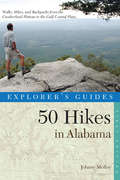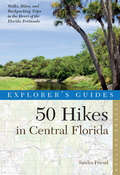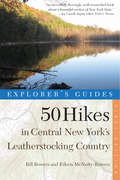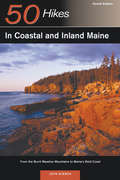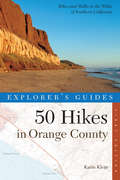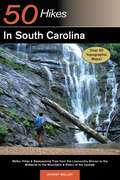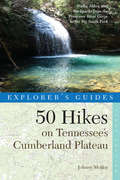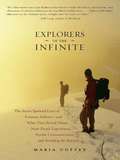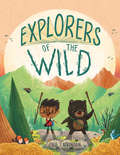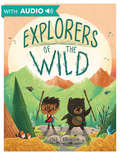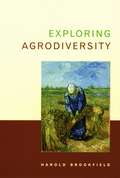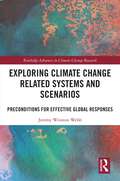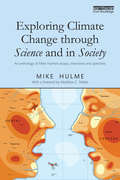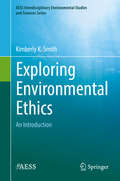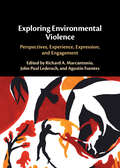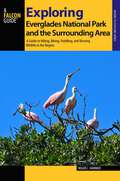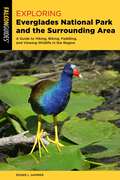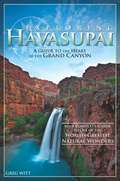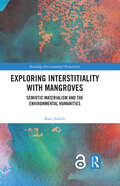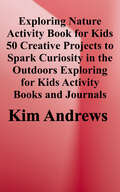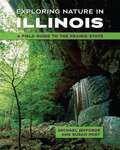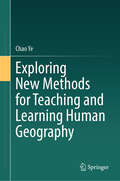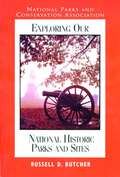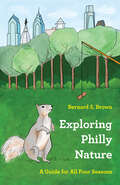- Table View
- List View
Explorer's Guide 50 Hikes in Alabama
by Johnny MolloyA hike for every interest and ability! Alabama has so many great hikes to offer, including those in national and state parks and forests and in national wildlife refuges. In this book, the emphasis is on the most scenic destinations and unique places that help make Alabama so beautiful, like the rock formations of the Wall of Jericho, or the dunes of Bon Secour. Many hikes described here are off-the-beaten-path treks to lesser-known sites such as Needles Eye and Blue Spring; they show visitors the state’s wide range of beauty and biodiversity. Others take place at various spots along the Pinhoti Trail, the master path through Alabama’s mountains.
Explorer's Guide 50 Hikes in Central Florida (Second Edition) (Explorer's 50 Hikes)
by Sandra FriendA hike for every interest and ability! Florida’s landscape is a marvel of diversity, and Central Florida is its pinnacle. Footpaths range through salt marshes, river floodplains, and along coastal dunes and beaches. Trails pass through desert-like scrub islands, jungle-like hydric hammocks, and deep, dark bayous. There’s no better way to take in this natural world than by walking it. Ranging from 1 to 43 miles in length, each hike includes mile-by-mile directions, a topographic map, and information on hike duration, mileage, and trail conditions. This new edition includes 20 new places to explore, from hidden urban gems like the Circle Bar B Ranch in Lakeland and Ponce Preserve in Daytona Beach to the quiet rural landscapes of Catfish Creek State Park and Chinsegut Hill. Old standards like Tenoroc, Disney Wilderness Preserve, and Silver River State Park have been revisited and updated to keep you informed of changes in their trail systems.
Explorer's Guide 50 Hikes in Central New York's Leatherstocking Country (Explorer's 50 Hikes)
by Bill Bowers Eileen Mcnulty-BowersRich in Native American and Revolutionary War history, New York State's Leatherstocking Country is a hiker's paradise, blessed with a scenic rural landscape and abundant flora and fauna. Longtime central New York residents and avid hikers Bill and Eileen Bowers guide you through some of the best hiking opportunities in central New York, from the eastern shore of Lake Ontario and the Syracuse region to the Southern Tier, the northern Catskills, the Erie Canalway Trail, and much more. The hikes in this addition to in Countryman's acclaimed Explorer's Guide 50 Hikes series range in length and difficulty from half-mile nature trails suitable for families with children to strenuous daylong treks across rough terrain. A "Hikes at a Glance" table makes it easy to choose hikes for every interest and ability level. Each hike description includes mile-by-mile directions, information on hiking time, mileage, and trail conditions, as well as knowledgeable commentary on the natural and human history you'll encounter along the way.
Explorer's Guide 50 Hikes in Coastal and Inland Maine: From the Burnt Meadow Mountains to Maine's Bold Coast (Fourth Edition) (Explorer's 50 Hikes)
by John GibsonA best-selling hiking guide to Maine's most widely traveled region, completely revised and with six new hikes. This longstanding guide in the Explorer's Guide 50 Hikes series describes the best hikes in the Western Mountains, the Oxford Hills, Evans Notch Range, the Mahoosuc Range, the Camden Hills, Monhegan Island, and Acadia National Park on Mount Desert Island. Locals and visitors will find miles of satisfying hiking, with outings that range from short walks for families to all-day excursions for serious hikers. Each hike description includes a topographic map, information on difficulty, mileage, and elevation, and a detailed description of the route. An overview chart at the beginning of the book describes the 50 hikes at a glance for easy trip planning.
Explorer's Guide 50 Hikes in Orange County
by Karin KleinA hike for every interest and ability! This brand-new entry in the popular Explorer's 50 Hikes series covers the most interesting hiking trails in Orange County, California, providing diverse hikes in a variety of wilderness environments: from a short walk along a concrete channel to see endangered green sea turtles to more challenging hikes to find tide pools, waterfalls, and the treasures of the county’s private nature preserves. Each hike provides detailed directions and maps and offers a unique perspective on its environs—whether hot springs, earthquake faults, or vibrant wildflower displays—giving as close an experience as possible to hiking with a live guide. Several area hikes are available only in this book, making it a must-have for your California sojourn.
Explorer's Guide 50 Hikes in South Carolina: Walks, Hikes & Backpacking Trips from the Lowcountry Shores to the Midlands to the Mountains & Rivers of the Upstate (Explorer's 50 Hikes)
by Johnny MolloySeasoned hiking author Johnny Molloy details 50 hikes of varied lengths and difficulties throughout verdant South Carolina, from the Chattooga River to the varied terrain of the Midlands, including Congaree National Park, all the way to the Lowcountry, land of beaches and forgotten swamps and designated wildernesses. Specific emphasis is placed on the most scenic destinations and unique places that make the Palmetto State special. Each hike includes a helpful information section, trail map, trailhead directions, and stunning photographs, with intriguing commentary about the human or natural history along the way.
Explorer's Guide 50 Hikes on Tennessee's Cumberland Plateau: Walks, Hikes, and Backpacks from the Tennessee River Gorge to the Big South Fork and throughout the Cumberlands
by Johnny MolloyExperience great hiking in the scenic swath of Tennessee between Nashville and Knoxville. Tennessee’s Cumberland Plateau, a wide tableland cut with a dizzying array of deep gorges, is a geological wonderland. It is a place to behold and a place to savor. This new entry in the trusted series details 50 hikes on the plateau, from the Big South Fork National River & Recreation Area near Kentucky to the fascinating Walls of Jericho astride the Alabama state line; from the thousand-foot gorge cut by the mighty Tennessee River down Chattanooga way to the watery beauty of Virgin Falls by Sparta. It will encourage you to get out and enjoy the treasures of Tennessee’s unspoiled Cumberland Plateau. Specific emphasis is placed on the most scenic destinations and the unique places that make the plateau so special, places like the Great Stone Door, with its sandstone formations and vertical rock walls, and Cumberland Mountain State Park, with its ancient trees and evidence of human history. Also included are comprehensive maps for each hike, scenic photos, and a Hikes-at-a-Glance table that makes choosing your desired hike a breeze.
Explorers of the Infinite
by Maria CoffeyReal-life psychic, near-death, and paranormal experiences are combined with cutting-edge science and vivid adventure stories in this energetic look at why extreme athletes and mountaineers take the risks that allow them to push the limits of consciousness, and what they encounter there. In the life-or-death world of extreme adventure sports, there is one thing that athletes often keep quiet about: the #147;forbidden” territory of paranormal experiences. Ranging from fleeting moments of transcendence to full-blown encounters with ghosts and everything in between#151;visions, near-death experiences, psychic communication#151;many extreme athletes have experienced these moments of connection with the beyond, but have been reluctant to talk about them. In Explorers of the Infinite, award-winning outdoors journalist and lifelong adventure sports devotee Maria Coffey probes the mystical and paranormal experiences of mountaineers, snowboarders, surfers, and more. She reviews cutting-edge science, and consults the history of philosophy and spirituality to answer the question: Could the state of intense #147;aliveness” that is the allure of extreme sports for so many actually be a route to a connection with the beyond? Coffey investigates the scientific explanations for mystical phenomena, ranging from simple explanations to theories from consciousness studies and quantum physics, and leaves us wondering where science ends and spirituality begins. An energetic, you-are-there look at the spiritual lives of extreme athletes, Explorers of the Infinite asks why extreme athletes take the risks that allow them to push the limits of consciousness, what they encounter there, and what we can learn from them.
Explorers of the Wild (Hyperion Picture Book (eBook))
by Cale AtkinsonBoy and Bear both love to explore the outdoors. There are so many neat things to see, and so many strange things to find. These explorers are prepared for anything . . . except each other! When Bear and Boy meet in the woods, they're scared at first. Really scared. But soon these kings of the wild realize that no mountain is too big to conquer if you have a friend to climb it by your side. Praise for Explorers of the Wild "[An] exquisite book . . . [with] ravishing art." -- USA TodayPraise for To the Sea "A whale's tale that dives deep and surfaces with useful lessons about making, keeping, and helping friends." -- Kirkus Reviews "An unusual and appealing story about friendship." -- School Library Journal
Explorers of the Wild: An eBook with Audio (Hyperion Picture Book (ebook) Ser.)
by Cale AtkinsonBoy and Bear both love to explore the outdoors. There are so many neat things to see, and so many strange things to find. These explorers are prepared for anything . . . except each other! When Bear and Boy meet in the woods, they're scared at first. Really scared. But soon these kings of the wild realize that no mountain is too big to conquer if you have a friend to climb it by your side. Praise for Explorers of the Wild "[An] exquisite book . . . [with] ravishing art." -USA Today Praise for To the Sea"A whale's tale that dives deep and surfaces with useful lessons about making, keeping, and helping friends." -Kirkus Reviews "An unusual and appealing story about friendship." -School Library Journal
Exploring Agrodiversity (Issues, Cases, and Methods in Biodiversity Conservation)
by Harold BrookfieldSmall farmers are often viewed as engaging in wasteful practices that wreak ecological havoc. Exploring Agrodiversity sets the record straight: Small farmers are in fact ingenious and inventive and engage in a diverse range of land-management strategies, many of them resourcefully geared toward conserving resources, especially soil. They have shown considerable resilience in the face of major onslaughts against their way of life by outsiders and government.Using case studies from Africa, Asia, Latin America, and the Pacific, this book provides in-depth analysis of agricultural diversity and explores its history. The book also considers the effect of the "gene revolution" on small farmers and reviews the effects of the "green revolution" in Asian countries. In conclusion, it questions whether the diverse agricultural practices employed by small farmers can survive modern pressures and the global ambitions of the biotechnology industry.
Exploring Climate Change Related Systems and Scenarios: Preconditions for Effective Global Responses (Routledge Advances in Climate Change Research)
by Jeremy Winston WebbJeremy Webb draws on multiple disciplines to piece together the climate change puzzle, identifying what it would take to limit climate change and its impacts.The book starts with a summary of the climate change problem and develops a Climate Change, National Interests, International Cooperation (CCNIIC) model of the climate response system. Webb reviews ‘reverse stress testing’, ‘backcasting’, and ‘theory of change’ methods, showing how they can be used to collect a large sample of possible futures. He also shows how we can explore the multiverse of futures using a new method called thematic chain analysis, finding relevant connections across scenarios. In the second half of the book, Webb explores 175 scenarios collected through 27 interviews with climate change experts. From these scenarios a signal response model is developed. Preconditions for effective social change and behaviour, political will and policy, as well as business and economic activity are synthesised. Lessons include preconditions for effective global responses to climate change, showing what it takes to limit climate change and related impacts. The book finishes with an epilogue, applying the signal response model and preconditions for effective global responses to COVID-19, demonstrating that models from this book can be applied to other global response problems – and used to quickly assess possible response strategies.This book will be of great interest to students and scholars of climate change, environmental policy and future studies.
Exploring Climate Change through Science and in Society: An anthology of Mike Hulme's essays, interviews and speeches
by Mike HulmeMike Hulme has been studying climate change for over thirty years and is today one of the most distinctive and recognisable voices speaking internationally about climate change in the academy, in public and in the media. The argument that he has made powerfully over the last few years is that climate change has to be understood as much as an idea situated in different cultural contexts as it is as a physical phenomenon to be studied through universal scientific practices. Climate change at its core embraces both science and society, both knowledge and culture. Hulme’s numerous academic and popular writings have explored what this perspective means for the different ways climate change is studied, narrated, argued over and acted upon. Exploring Climate Change through Science and in Society gathers together for the first time a collection of his most popular, prominent and controversial articles, essays, speeches, interviews and reviews dating back to the late 1980s. The 50 or so short items are grouped together in seven themes - Science, Researching, Culture, Policy, Communicating, Controversy, Futures - and within each theme are arranged chronologically to reveal changing ideas, evidence and perspectives about climate change. Each themed section is preceded with a brief introduction, drawing out the main issues examined. Three substantive unpublished new essays have been specially written for the book, including one reflecting on the legacy of Climategate. Taken as a collection, these writings reveal the changes in scientific and public understandings of climate change since the late 1980s, as refracted through the mind and expression of one leading academic and public commentator. The collection shows the many different ways in which it is necessary to approach the idea of climate change to interpret and make sense of the divergent and discordant voices proclaiming it in the public sphere.
Exploring Environmental Ethics: An Introduction (Aess Interdisciplinary Environmental Studies And Sciences Ser.)
by Kimberly K. SmithThis book is designed as a basic text for courses that are part of an interdisciplinary program in environmental studies. The intended reader is anyone who expects environmental stewardship to be an important part of his or her life, as a citizen, a policy maker, or an environmental management professional. In addition to discussing major issues in environmental ethics, it invites readers to think about how an ethicist's perspective differs from the perspectives encountered in other environmental studies courses. Additional topics covered include corporate social responsibility, ecological citizenship, property theory, and the concept of stewardship as a vocation.
Exploring Environmental Violence: Perspectives, Experience, Expression, and Engagement
by Agustín Fuentes John Paul Lederach Richard A. MarcantonioThe contributors to this book represent a wide breadth of scholarly approaches, including law, social and environmental science, engineering, as well as from the arts and humanities. The chapters explore what environmental violence is and does, and the variety of ways in which it affects different communities. The authors draw on empirical data from around the globe, including Ukraine, French Polynesia, Latin America, and the Arctic. The variety of responses to environmental violence by different communities, whether through active resistance or the creative arts, are also discussed, providing the foundation on which to build alternatives to the potentially damaging trajectory on which humans currently find themselves. This book is indispensable for researchers and policymakers in environmental policy and peacebuilding. This title is also available as Open Access on Cambridge Core.
Exploring Everglades National Park and the Surrounding Area: A Guide to Hiking, Biking, Paddling, and Viewing Wildlife in the Region (Exploring Series)
by Roger L. HammerThis is the ultimate guide to discovering the vast "River of Grass" ecoregion of the southern Florida mainland. Packed with photographs, maps, and informative text, this guide will help outdoor enthusiasts appreciate the landscape and varied flora and fauna of this watershed whether they have a day to spend in the effort or a lifetime. This edition includes new routes in Biscayne National Park. Whether traveling by canoe or by foot, this guide will enhance the next journey into the remarkable Everglades.
Exploring Everglades National Park and the Surrounding Area: A Guide to Hiking, Biking, Paddling, and Viewing Wildlife in the Region (Exploring Series)
by Roger L. HammerThis is the ultimate guide to discovering the vast "River of Grass" ecoregion of the southern Florida mainland. Packed with photographs, maps, and informative text, this guide will help outdoor enthusiasts appreciate the landscape and varied flora and fauna of the watershed whether they have a day to spend in the effort or a lifetime. This edition includes new routes in the Biscayne National Park. Whether traveling by canoe or by foot, this guide will enhance the next journey into the remarkable Everglades.
Exploring Havasupai
by Greg WittDeep in the Grand Canyon lies a place of unmatched beauty; a place where blue-green water cascades over fern-clad cliffs into travertine pools, where great blue heron skim canyon streams, and where giant cottonwoods and graceful willows thrive in the shade of majestic sandstone cliffs. Havasupai is a paradise enveloped in one of the earth's most rugged and parched landscapes. The Havasupai Tribe has never advertised its canyon and has never endorsed a guidebook to prepare visitors for a journey into the Heart of the Grand Canyon - until now. Exploring Havasupai is the essential destination guide for those visiting the area. The guidebook is filled with insider tips, fascinating background, and essential information. It identifies many new hikes, mines, springs and historical sites never before revealed in a Grand Canyon or Havasupai guidebook. Details on canyon geology, weather patterns, and the unique flora and fauna add depth to a hiker's experience. Exploring Havasupai includes detailed maps, trail descriptions, stunning full-color photographs, and intriguing historical insights. This is the must-have guide for canyon visitors, whether arriving by helicopter, on horseback, or on foot.
Exploring Interstitiality with Mangroves: Semiotic Materialism and the Environmental Humanities (Routledge Environmental Humanities)
by Kate JudithMangroves thrive in intertidal zones, where they gather organisms and objects from land, river, and ocean. They develop into complex ecologies in these dynamic in-between spaces. Mobilising resources drawn from semiotic materialism and the environmental humanities, this book seeks a form of social theory from the mangroves; that is to think interstitiality from the perspective of mangroves themselves, exploring the crafty and tenacious world-making they are engaged in. Three sections weave together theory, science and close observation, responding to calls within the environmental humanities for detailed attention to interactions in marginal spaces and those of interpretative tension. It examines interstitiality by considering theories of difference, relationality, and reflexivity in the context of mangrove socioecological materialities, drawing on influential writers such as Michel Serres, Jacques Derrida, Deborah Bird Rose, Donna Haraway, Brian Massumi and Maurice Merleau-Ponty as theoretical touchstones. Exploring Interstitiality with Mangroves is a lyrically crafted philosophical analysis that will appeal to scholars, researchers and students interested in the developing frontiers of more-than-human post-anthropocentric writing, theory and methodologies. It will be of interest to readers in ecocriticism, environmental humanities, cultural geography, place studies and nature writing.
Exploring Nature Activity Book for Kids: 50 Creative Projects to Spark Curiosity in the Outdoors
by Kim AndrewsA guide to exploring the great outdoors for kids ages 6 to 12. Encourage young nature lovers to get outside and track, explore, discover, and create. This book is filled with hands-on, educational outdoor activities that kids will love to learn from, like crafting bird feeders out of fruit, pressing flowers, or creating sundials. They'll get their hands dirty and their imaginations revving while staying active outside. <p><p>This standout among nature books for kids includes: 50 Fun outdoor projects―Inspire a lifetime of curiosity with tons of guided, interactive ideas that let kids observe animals, plants, and even outer space in action. <p>Activities for everyone, everywhere―the fun and games inside cover a range of seasons and regions so all kids can start exploring, no matter where they are. <p>Important skill-building--By stopping to notice and record what's going on around them, kids will practice important skills like observation, memory, writing, drawing, wildlife safety, and more. <p><p>This hands-on approach to nature books for kids will show kids what makes the great outdoors great.
Exploring Nature in Illinois: A Field Guide to the Prairie State
by Susan Post Michael JeffordsLoaded with full color photographs and evocative descriptions, Exploring Nature in Illinois provides a panorama of the state's overlooked natural diversity. Naturalists Michael Jeffords and Susan Post explore fifty preserves, forests, restoration areas, and parks, bringing an expert view to wildlife and landscapes and looking beyond the obvious to uncover the unexpected beauty of Illinois's wild places. From the colorful variety of birds at War Bluff Valley Audubon Sanctuary to the exposed bedrock and cliff faces of Apple River Canyon, Exploring Nature in Illinois will inspire readers to explore wonders hidden from urban sprawl and cultivated farmland. Maps and descriptions help travelers access even hard-to-find sites while a wealth of detail and photography offers nature-lovers insights into the flora, fauna, and other aspects of vibrant settings and ecosystems. The authors also include diary entries describing their own impressions of and engagement with the sites. A unique and much-needed reference, Exploring Nature in Illinois will entertain and enlighten hikers, cyclers, students and scouts, morning walkers, weekend drivers, and anyone else seeking to get back to nature in the Prairie State.
Exploring New Methods for Teaching and Learning Human Geography
by Chao YeThis book proposes a new and central teaching concept "we are all makers" and innovates the geographical teaching modes and methodology. Geography teaching, especially how to teach geographical thinking, is important and related to the development of the discipline. In this field, the exploration of new teaching methods in non-English speaking countries and regions still needs to grow. Based on the author's experience of teaching geographical thinking and human (cultural) geography for more than ten years, the book links geographical thinking to the realistic cases with new social media tools such as WeChat APP and blog. Under the guidance of these new methods, such as poem, emotional, couplet game, keywords, blog-based teaching, and the like, students are transformed from passive recipients of knowledge to active learners and even creators in the end. The book, which focuses on and pioneers new teaching methodology or methods, is used as a reference by scholars, researchers, practitioners, and readers specialized in fields such as geography, education, and pedagogy.
Exploring Our National Parks and Sites
by Russell D. ButcherThe essential guide to the land and history of the US national historical parks and sites. It is the sequel to Exploring National Parks and Monuments.
Exploring Philly Nature: A Guide for All Four Seasons
by Bernard S. BrownDo snakes and salamanders fascinate you or make you squeamish? Have you ever listened closely to the birds chirping in your neighborhood? Can you identify the flowers growing in Philadelphia’s urban parks? (Moreover, are the mushrooms safe to eat?) Exploring Philly Nature is amateur naturalist, urban herper,* and Grid contributor Bernard Brown’s handy guide to experiencing the flora and fauna in Philly. This compact illustrated volume contains 52 activities from birding, (squirrel) fishing, and basement bug-hunting to joining a frog call survey and visiting a mussel hatchery. Brown encourages kids (as well as their parents) to connect with the natural world close to home. Each entry contains information on where and when to participate, what you will need (even if it is only patience), and tips on clubs and organizations to contact for access. The city and its environs contain a multitude of species from the lichen that grows on gravestones or trees to nocturnal animals like opossums, bats, and raccoons. Exploring Philly Nature is designed to get readers eager to discover, observe, and learn more about the concrete jungle that is Philadelphia.
Exploring Philly Nature: A Guide for All Four Seasons
by Bernard S. BrownDo snakes and salamanders fascinate you or make you squeamish? Have you ever listened closely to the birds chirping in your neighborhood? Can you identify the flowers growing in Philadelphia’s urban parks? (Moreover, are the mushrooms safe to eat?) Exploring Philly Nature is amateur naturalist, urban herper,* and Grid contributor Bernard Brown’s handy guide to experiencing the flora and fauna in Philly. This compact illustrated volume contains 52 activities from birding, (squirrel) fishing, and basement bug-hunting to joining a frog call survey and visiting a mussel hatchery. Brown encourages kids (as well as their parents) to connect with the natural world close to home. Each entry contains information on where and when to participate, what you will need (even if it is only patience), and tips on clubs and organizations to contact for access. The city and its environs contain a multitude of species from the lichen that grows on gravestones or trees to nocturnal animals like opossums, bats, and raccoons. Exploring Philly Nature is designed to get readers eager to discover, observe, and learn more about the concrete jungle that is Philadelphia.
